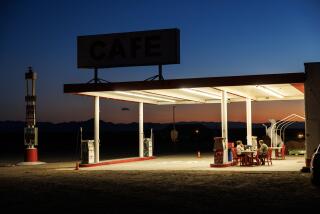Sixty-six years ago, the country’s first transcontinental...
- Share via
Sixty-six years ago, the country’s first transcontinental highway opened from Chicago to Los Angeles. Over the decades, Route 66--immortalized as the “Mother Road” by the writer John Steinbeck--became famous as either a real or imagined escape route for snowbound Midwesterners who longed for the smell of Pacific Ocean salt air and California orange blossoms.
On Monday at 7 p.m. at the Glendora Public Library, Vivian Davies, who is the secretary-treasurer of the California Historic Route 66 Assn., will present a free slide show, annotated with her own recollections, about the highway.
Davies, 74, loves nothing more than to talk about the roadway. As a teen-ager living in a Chicago suburb, she learned to drive on Route 66, motoring west with her family on a visit to Southern California.
“Route 66 brought everybody to California to fulfill their hopes and dreams,” she said. “They were going West to find a better life. It’s part of American history.”
In her talk, Davies will focus on the 300 California miles of the 2,200-mile roadway, which became a dinosaur of the automotive age. In 1984, amid the new world of fast-food franchises, self-serve filling stations and interstate highways, Route 66 was taken off the maps.
Davies also will discuss the San Gabriel Valley path of Route 66, which traversed portions of Foothill Boulevard, Huntington Drive and Colorado Boulevard.
The lecture is sponsored by the Glendora Historical Society. The library is at 140 S. Glendora Ave., less than half a mile north of the Route 66 path where it followed Alosta Avenue.
Information about the California Historic Route 66 Assn. is available by calling (714) 593-4046 or writing to 2127 Foothill Blvd., 66, La Verne, Calif. 91750.
More to Read
Sign up for Essential California
The most important California stories and recommendations in your inbox every morning.
You may occasionally receive promotional content from the Los Angeles Times.













